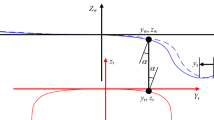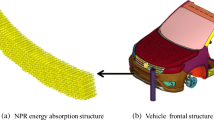Abstract
The CRH1 train is one of the main commuter trains in China which is mostly operating on typical and high-speed lines. Previously, a high-speed car wheel profile was used on the CRH1 train, but it does not match well with the train suspension parameters and also causes the instability of the train on tangent track and large curved track. Therefore, a new profile was designed as the replacement of the old one for the CRH1 train. However, the use of the new profile results in the serious wheel flange and rail gauge corner wear but it can provide better stability compared to the old profile. This paper first presents the evaluation of using the two profiles, and then a development of the wheel profile is objected in terms of both currently used profiles, which is not only to minimize the flange wear and also take the vehicle dynamic behavior into consideration. A multi-objective optimization method was, therefore, to propose for the minimization of the lateral force and the stability of wheelsets. The requirements of the wheel profile geometry are investigated through proposed optimization method. Finally, the profile satisfied the safety requirements of the vehicle has been provided by using the particle swarm optimization method. Furthermore, the evaluation of vehicle dynamic has been performed by using Multi-Body Simulation Software. The entire design process has been completed in a closed-loop procedure programed in MATLAB. The findings show that the developed profile after the optimization procedure is fairly acceptable for the requirements of the wheel-rail interface and dynamic behavior of CRH1 train.



















Similar content being viewed by others
References
Clerc M, Kennedy J (2002) The particle swarm-explosion, stability, and convergence in a multidimensional complex space. IEEE Trans Evol Comput 6(1):58–73
Cui D, Li L, Jin X, Li L (2010) Wheel-rail profiles matching design considering railway track parameters. Chin J Mech Eng 23(4):410–417
Cui D, Li L, Jin X (2011) Optimal design of wheel profiles based on weighted wheel/rail gap. Wear 271:218–222
Cui D, Wang H, Li L, Jin X (2015) Optimal design of wheel profile for high-speed train. P I MECH ENG F-J RAI 229(3):248–261
Cui D, Zhang W, Tian G et al (2016) Designing the key parameters of EMU bogie to reduce side wear of rail. Wear 366-367:49–59
Haque I, Latimer DA, Law EH (1989) Computer-aided wheel profile design for railway vehicles. ASME J Eng Ind 111:288–291
Heumann H (1934) Zur Frage des Radreifen-umrisses. Organ Forts Eisenba 89(18):336–342
Ignesti M, Innocenti A, Marini L, Meli E, Rindi A, Toni P (2013) Wheel profile optimization on railway vehicles from the wear viewpoint. Int J Nonlin Mech 53:41–54
Jahed H, Farshi B, Eshraghi MA, Nasr A (2008) A numerical optimization technique for design of wheel profiles. Wear 264:1–10
Jin X, Shen Z (2001) Development of rolling contact mechanics of wheel/rail systems. Adv Mech 31(1):33–46
Liu X (2000) Development of arc-shaped tread contour for locomotives and rolling stock. Rolling Stock 38(2):24–28
Markine VL, Shevtsov IY, Esveld C (2007) An inverse shape design method for railway wheel profiles. Struct Multidiscip Optim 33:243–253
Polach O (2011) Wheel profile design for target conicity and wide tread wear spreading. Wear 271:195–201
Ratnaweera A, Halgamuge S (2004) Self-organizing hierarchical particle swarm optimizer with time-varying acceleration coefficients. IEEE Trans Evol Comput 8(3):240–255
Sato E (2000) The scientific design of wheel tread shape. J Fore dies Locom 3:39–43
Sato Y (2005) History study on designing Japanese rail profiles. Wear 258(7–8):1064–1070
Shen G, Ayasse JB, Chollet H et al (2003) A unique design method for wheel profiles by considering the contact angle function. Proc IMechE F J Rail Rapid Transit 217:25–30
Shen G, Chollet H, Ye Z (2005) Study on wheel profile and contact analysis. J Chin Rai Soci 27(4):25–29
Shen G, Zhong X (2010) Inverse method for design of wheel profiles for railway vehicles. J Mech Eng 16:41–47
Shevtsov IY, Markine VL, Esveld C (2005) Optimal design of wheel profile for railway vehicles. Wear 258:1002–1030
Wickens AH (1998) Dynamics of railway vehicles - from Stephenson to Carter. Proc Inst Mech Eng F J Rail Rapid Transit 212(3):209–217
Wu H M. (2000). Investigations of wheel/rail interaction on wheel flange climb derailment and wheel/rail profile compatibility [D]. The Graduate College of the IIT
Yang G (1978a) A preliminary study of wheel tread shape (upper section)[J]. Rolling stock 11:1–6
Yang G (1978b) A preliminary study of wheel tread shape (lower section)[J]. Rolling stock 12:1–17
Zhang J, Wen Z, Sun L, Jin X (2008) Wheel profile design based on rail profile expansion method. Chin J Mech Eng 44(3):44–49
Zhang S, Gu J (2009) Thinking and assumption of independent innovation of wheelset for high-speed cars in China. Rolling stock 47(3):1–5
Funding
The present work has been supported by the National Natural Science Foundation of China (Nos. 51605394 and U1434210), the Department of Education Foundation of Sichuan Province (No. 16ZB0011), and the Key Research Project of Leshan City (No. 16ZDYJ0147).
Author information
Authors and Affiliations
Corresponding author
Additional information
Responsible editor: Somanath Nagendra
Publisher’s Note
Springer Nature remains neutral with regard to jurisdictional claims in published maps and institutional affiliations.
Rights and permissions
About this article
Cite this article
Cui, D., Wang, R., Allen, P. et al. Multi-objective optimization of electric multiple unit wheel profile from wheel flange wear viewpoint. Struct Multidisc Optim 59, 279–289 (2019). https://doi.org/10.1007/s00158-018-2065-5
Received:
Revised:
Accepted:
Published:
Issue Date:
DOI: https://doi.org/10.1007/s00158-018-2065-5




